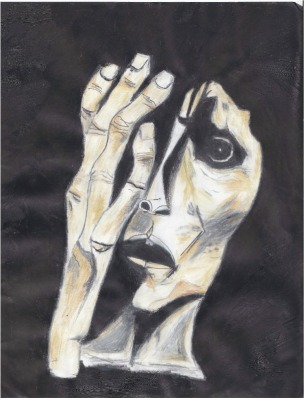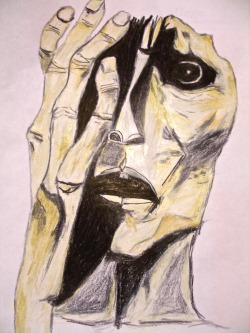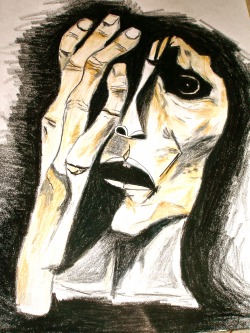"All that we know is still infinitely less than all that still remains unknown."
~William Harvey
~William Harvey
Oswaldo Guaysamin

Screaming the past, for the sake of the future
July 6, 1919 – March 10
Looking through Oswaldo Guayasamin’s work online I came upon a painting that after first glance I couldn’t move on from it, I saw more and more with the passing time that I spent looking at the image. I couldn’t decide if the person depicted in the painting was sad, making me feel pity, or maybe it was a look of concern and at one point I even thought the person looking back at me was mad that I was looking.
I was first drawn to this particular painting because of the subtle eye. The eye is made up of a thin lightly penned line surrounded by what looks to me, one layer of black paint. The other eye and the whole other side of the face is covered by a gracefully tortured looking hand with long fingers.
The color palette of this painting is made up of earthly, fleshy tones like yellowish crèmes, browns and grey with a deep black that encompasses the image. With these colors Guayasamin creates a raw depth. The shadows of the nose, chin and neck are realistically placed but in an abstract way. Bold lines and awkward forms are what make up the hand. In the black, I felt like there was more behind just the color. The curves and depressions of the face and fingers remind me of the endless rock formations I watched pass by on a road trip I took when I was younger to Colorado.
I can’t identify the sex of the person in the painting so it must mean it is unimportant, the person could just be the representative of all people, mankind. The facial expression of the figure reminds of me war, this sense of not being able to look at it all (the covering of one eye) but when seeing some of the atrocities, being horrified. The covering of one eye could also give a spectator the impression that the person (or mankind) does not see the full picture and conceals one eye from the truth because it is too horrible to look at.
Hands are muti-purpose tools humans’ use everyday. I would say the indigenous use their hands more actively in their daily lives then, for example people from the United States. From arts and crafts to preparing food, most things are hand done in the indigenous life. In this painting the hand is very prominent as an expressive tool. But because the hand takes up half the picture this may be an indication that this person is indigenous, the hands are not delicate looking either. The stoic sort of ancient colors and structure supports this idea.
The mouth is a puzzling aspect of this picture because of the range of possible things it is trying to say, speechless is one. The ends of the mouth are curved down and the lips are thinly outlined with sharp lines. The mouth is opened showing pure blackness inside and what looks like to me, a hint of two front teeth but no others are shown. The mouth is opened wide enough to make me think the person is expressing awe in an opened, unbelieving sort of way. Another possibility that makes more sense is that the person is screaming, but not loudly in frustration as there are no wrinkles in the forehead, but a soft, even silent, sad scream.
After my initial reactions to this painting I researched when it was painted and found that it was made in an era of his work, some call, the Age of Anger between 1961 and 1990. This painting is called El Grito III (The Scream) and is part of a series of three. Guayasamin’s father, of indigenous Quechua descent and his mother, a Meztiza of the same tribe raised Guayasamin humbly along many brothers and sisters in Quito, Ecuador. An artist’s roots are always a big part of their creations and I think this holds true for Oswaldo Guayasamin as well. He was an activist and took many risks in his art to show the truth about the Indigenous struggle, the injustices of poverty and the destruction of war. People say, “He creates trustingly a portrait of the human and social differences as criticism towards the reality that we live now a days in our society.” (Remedios Varo Art-Oswaldo Guayasamin Biography)
When looking at the three part series of these paintings I can see why they are called el Grito. The third, the one that I looked at, is the least dramatic out of all of them. The first and the second paintings continue with the theme of the hands being the main expresser but the emotions seem more tangible and extreme. There is a mad scream with hands begging in one and the other is a shocked scream with a hand covering the mouth.
Guayasamin is able to capture the human and depict the raw moments of an emotion making the viewer able to have a connection. Looking at this painting my reactions manifested in emotions of deep unnerving and uncomfortable sadness. I think this is the kind of reaction that Guayasamin wishes, to provoke the viewer to make them understanding the feelings of a group that maybe on the outside, from afar could not be understood. He represents the unrepresented (especially in the art world), the indigenous. What Oswaldo Guayasamin says about his art is that “My painting is to hurt, to scratch and hit inside people’s hearts. To show what Man does against Man.” For me, this goal was achieved.
July 6, 1919 – March 10
Looking through Oswaldo Guayasamin’s work online I came upon a painting that after first glance I couldn’t move on from it, I saw more and more with the passing time that I spent looking at the image. I couldn’t decide if the person depicted in the painting was sad, making me feel pity, or maybe it was a look of concern and at one point I even thought the person looking back at me was mad that I was looking.
I was first drawn to this particular painting because of the subtle eye. The eye is made up of a thin lightly penned line surrounded by what looks to me, one layer of black paint. The other eye and the whole other side of the face is covered by a gracefully tortured looking hand with long fingers.
The color palette of this painting is made up of earthly, fleshy tones like yellowish crèmes, browns and grey with a deep black that encompasses the image. With these colors Guayasamin creates a raw depth. The shadows of the nose, chin and neck are realistically placed but in an abstract way. Bold lines and awkward forms are what make up the hand. In the black, I felt like there was more behind just the color. The curves and depressions of the face and fingers remind me of the endless rock formations I watched pass by on a road trip I took when I was younger to Colorado.
I can’t identify the sex of the person in the painting so it must mean it is unimportant, the person could just be the representative of all people, mankind. The facial expression of the figure reminds of me war, this sense of not being able to look at it all (the covering of one eye) but when seeing some of the atrocities, being horrified. The covering of one eye could also give a spectator the impression that the person (or mankind) does not see the full picture and conceals one eye from the truth because it is too horrible to look at.
Hands are muti-purpose tools humans’ use everyday. I would say the indigenous use their hands more actively in their daily lives then, for example people from the United States. From arts and crafts to preparing food, most things are hand done in the indigenous life. In this painting the hand is very prominent as an expressive tool. But because the hand takes up half the picture this may be an indication that this person is indigenous, the hands are not delicate looking either. The stoic sort of ancient colors and structure supports this idea.
The mouth is a puzzling aspect of this picture because of the range of possible things it is trying to say, speechless is one. The ends of the mouth are curved down and the lips are thinly outlined with sharp lines. The mouth is opened showing pure blackness inside and what looks like to me, a hint of two front teeth but no others are shown. The mouth is opened wide enough to make me think the person is expressing awe in an opened, unbelieving sort of way. Another possibility that makes more sense is that the person is screaming, but not loudly in frustration as there are no wrinkles in the forehead, but a soft, even silent, sad scream.
After my initial reactions to this painting I researched when it was painted and found that it was made in an era of his work, some call, the Age of Anger between 1961 and 1990. This painting is called El Grito III (The Scream) and is part of a series of three. Guayasamin’s father, of indigenous Quechua descent and his mother, a Meztiza of the same tribe raised Guayasamin humbly along many brothers and sisters in Quito, Ecuador. An artist’s roots are always a big part of their creations and I think this holds true for Oswaldo Guayasamin as well. He was an activist and took many risks in his art to show the truth about the Indigenous struggle, the injustices of poverty and the destruction of war. People say, “He creates trustingly a portrait of the human and social differences as criticism towards the reality that we live now a days in our society.” (Remedios Varo Art-Oswaldo Guayasamin Biography)
When looking at the three part series of these paintings I can see why they are called el Grito. The third, the one that I looked at, is the least dramatic out of all of them. The first and the second paintings continue with the theme of the hands being the main expresser but the emotions seem more tangible and extreme. There is a mad scream with hands begging in one and the other is a shocked scream with a hand covering the mouth.
Guayasamin is able to capture the human and depict the raw moments of an emotion making the viewer able to have a connection. Looking at this painting my reactions manifested in emotions of deep unnerving and uncomfortable sadness. I think this is the kind of reaction that Guayasamin wishes, to provoke the viewer to make them understanding the feelings of a group that maybe on the outside, from afar could not be understood. He represents the unrepresented (especially in the art world), the indigenous. What Oswaldo Guayasamin says about his art is that “My painting is to hurt, to scratch and hit inside people’s hearts. To show what Man does against Man.” For me, this goal was achieved.


